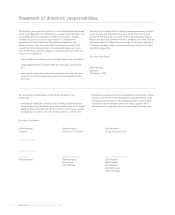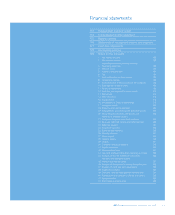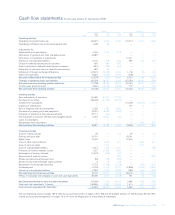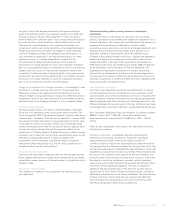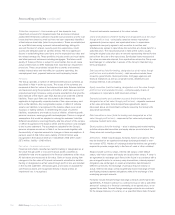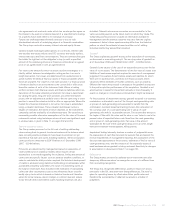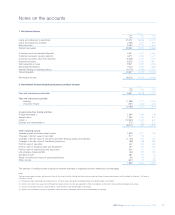RBS 2008 Annual Report Download - page 180
Download and view the complete annual report
Please find page 180 of the 2008 RBS annual report below. You can navigate through the pages in the report by either clicking on the pages listed below, or by using the keyword search tool below to find specific information within the annual report.
179RBS Group Annual Report and Accounts 2008
Fees in respect of services are recognised as the right to consideration
accrues through the provision of the service to the customer. The
arrangements are generally contractual and the cost of providing the
service is incurred as the service is rendered. The price is usually fixed
and always determinable. The application of this policy to significant fee
types is outlined below.
Payment services: this comprises income received for payment
services including cheques cashed, direct debits, Clearing House
Automated Payments (the UK electronic settlement system) and CHAPs
payments (the automated clearing house that processes direct debits
and direct credits). These are generally charged on a per transaction
basis. The income is earned when the payment or transaction occurs.
Charges for payment services are usually debited to the customer’s
account monthly or quarterly in arrears. Accruals are raised for services
provided but not charged at period end.
Card related services: fees from credit card business include:
•Commission received from retailers for processing credit and debit
card transactions: income is accrued to the income statement as the
service is performed;
•Interchange received: as issuer, the Group receives a fee
(interchange) each time a cardholder purchases goods and services.
The Group also receives interchange fees from other card issuers for
providing cash advances through its branch and Automated Teller
Machine networks. These fees are accrued once the transaction has
taken place; and
•An annual fee payable by a credit card holder is deferred and taken
to profit or loss over the period of the service i.e. 12 months.
Insurance brokerage: this is made up of fees and commissions
received from the agency sale of insurance. Commission on the sale of
an insurance contract is earned at the inception of the policy, as the
insurance has been arranged and placed. However, provision is made
where commission is refundable in the event of policy cancellation in
line with estimated cancellations.
Investment management fees: fees charged for managing investments
are recognised as revenue as the services are provided. Incremental
costs that are directly attributable to securing an investment
management contract are deferred and charged as expense as the
related revenue is recognised.
Insurance premiums: see accounting policy 12.
4. Assets held for sale and discontinued operations
A non-current asset (or disposal group) is classified as held for sale if
the Group will recover the carrying amount principally through a sale
transaction rather than through continuing use. A non-current asset (or
disposal group) classified as held for sale is measured at the lower of
its carrying amount and fair value less costs to sell. If the asset (or
disposal group) is acquired as part of a business combination it is
initially measured at fair value less costs to sell. Assets and liabilities of
disposal groups classified as held for sale and non-current assets
classified as held for sale are shown separately on the face of the
balance sheet.
The results of discontinued operations are shown as a single amount on
the face of the income statement comprising the post-tax profit or loss
of discontinued operations and the post-tax gain or loss recognised
either on measurement to fair value less costs to sell or on the disposal
of the discontinued operation. A discontinued operation is a cash-
generating unit or a group of cash-generating units that either has been
disposed of, or is classified as held for sale, and (a) represents a
separate major line of business or geographical area of operations, (b)
is part of a single co-ordinated plan to dispose of a separate major line
of business or geographical area of operations or (c) is a subsidiary
acquired exclusively with a view to resale.
5. Pensions and other post-retirement benefits
The Group provides post-retirement benefits in the form of pensions
and healthcare plans to eligible employees.
For defined benefit schemes, scheme liabilities are measured on an
actuarial basis using the projected unit credit method and discounted at
a rate that reflects the current rate of return on a high quality corporate
bond of equivalent term and currency to the scheme liabilities. Scheme
assets are measured at their fair value. Any surplus or deficit of scheme
assets over liabilities is recognised in the balance sheet as an asset
(surplus) or liability (deficit). The current service cost and any past
service costs together with the expected return on scheme assets less
the unwinding of the discount on the scheme liabilities is charged to
operating expenses. Actuarial gains and losses are recognised in full in
the period in which they occur outside profit or loss and presented in
the statement of recognised income and expense. Contributions to
defined contribution pension schemes are recognised in the income
statement when payable.
6. Intangible assets and goodwill
Intangible assets that are acquired by the Group are stated at cost less
accumulated amortisation and impairment losses. Amortisation is
charged to profit or loss over the assets’ estimated economic lives using
methods that best reflect the pattern of economic benefits and is
included in depreciation and amortisation. The estimated useful
economic lives are as follows:
Core deposit intangibles 6 to 10 years
Other acquired intangibles 5 to 10 years
Computer software 3 to 5 years
Expenditure on internally generated goodwill and brands is written-off
as incurred. Direct costs relating to the development of internal-use
computer software are capitalised once technical feasibility and
economic viability have been established. These costs include payroll,
the costs of materials and services, and directly attributable overheads.
Capitalisation of costs ceases when the software is capable of
operating as intended. During and after development, accumulated
costs are reviewed for impairment against the projected benefits that
the software is expected to generate. Costs incurred prior to the
establishment of technical feasibility and economic viability are
expensed as incurred as are all training costs and general overheads.
The costs of licences to use computer software that are expected to
generate economic benefits beyond one year are also capitalised.



